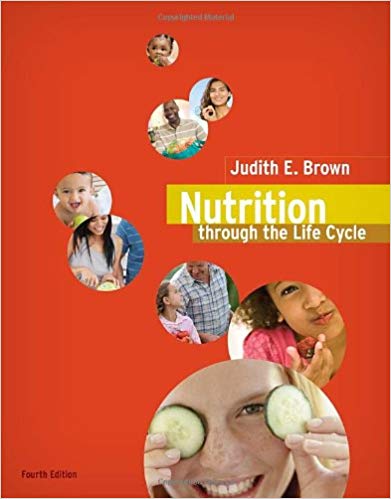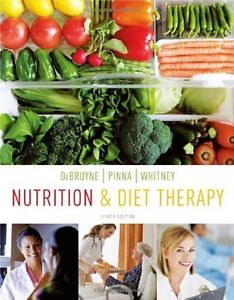Test Bank for Nutrition Through the Life Cycle 4th Edition By by Judith E. Brown
Original price was: $75.00.$50.00Current price is: $50.00.
Test banks are a great way to prepare for exams. They provide practice questions and answers, as well as explanations of the correct answer. Test banks can be used for both self-study and classroom instruction. The Test Bank for Nutrition Through The Life Cycle 4th Edition provides students with nutrition information that is essential for success in the course.
The Test Bank includes questions on all of the major topics covered in the textbook, as well as a variety of practice questions. In addition, the Test Bank provides an overview of the main concepts covered in each chapter. The Test Bank For Nutrition Through The Life Cycle 4th Edition is an excellent resource for any student who wants to improve their grades in the course. Order your copy today!
Digital item No Waiting Time Instant Download
ISBN-10: 0538733411, ISBN-13: 9780538733410
Description
Test Bank for Nutrition Through the Life Cycle 4th Edition By by Judith E. Brown
Test Bank for Chapter 3 – Preconception Nutrition:
Conditions and Interventions
Key to question types: F = fact-based; A = application; L, M, H = low, medium, high difficulty
Multiple Choice
Answer Page #
c, F, L 71 1. The definition of the periconceptual period is _____.
a. the developing organism from 8 weeks to the moment of birth
b. the month before conception
c. the month before and the month after conception
d. the month after conception
e. none of the above
e, F, M 71 2. Premenstrual dysphoric disorder (PMDD) is characterized by:
a. mood swings.
b. irritability.
c. depression.
d. physical symptoms.
e. all of the above
a, F 71 3. Which of the following would NOT be used to treat PMS symptoms?
a. Increasing intake of caffeine
b. Reducing stress
c. Taking supplements like magnesium and calcium
d. Increasing activity levels
e. Taking an antidepressant
a, F 71 4. Which of the following would NOT be considered a sign or symptom of premenstrual syndrome?
a. Swollen glands under the jaw
b. Fatigue
c. Craving salty or sweet food
d. Mood swings
e. Anxiety
d, F 71 5. Symptoms of PMS occur in about _____ of women of childbearing age.
a. 12%
b. 27%
c. 34%
d. 40%
e. 55%
d, A, H 79-80 6. Untreated phenylketonuria in pregnant women can lead to:
a. malformations in infants.
b. infants with microcephaly.
c. severe mental retardation in children.
d. all of the above
e. a and b only
c, F, L 72 7. A nutrient that would effectively treat swelling and breast tenderness in a woman with PMS is _____.
a. vitamin B6
b. calcium
c. magnesium
d. vitamin E
b, A 73 8. _____ is the first therapeutic option for infertility in obese people.
a. Medication
b. Weight reduction
c. Hormone therapy
d. In-vitro fertilization
e. Surgery
a, F, L 73 9. Central body obesity is best defined as _____.
a. a waist circumference > 35 inches in women
b. a waist circumference > 40 inches in women
c. a BMI measurement of weight (lb)/height2 (in)
d. a waist-to-height ratio measurement
e, A, M 75 10. An eating disorder that affects fertility is _____.
a. hypothalamic amenorrhea
b. anorexia nervosa
c. bulimia nervosa
d. celiac disease
e. b and c
d, F, L 75 11. The onset of hypothalamic amenorrhea is related to:
a. being underweight.
b. weight loss accompanied by intense exercise.
c. exposure to social stress.
d. all of the above
e. a and b only
b, F 77 12. Which of the following is an example of an autoimmune disease?
a. Phenylketonuria (PKU)
b. Type 1 diabetes
c. Type 2 diabetes
d. The female athlete triad
e. Polycystic ovary syndrome
a, A, H 76 13. _____ during the first 2 months of pregnancy is teratogenic and leads to a two- to three-fold risk of congenital abnormalities.
a. A high blood glucose level
b. Type 1 diabetes
c. Type 2 diabetes
d. Insulin resistance
e. Celiac disease
e, A 76 14. Diet strategies appropriate for people with type 2 diabetes include all of the following EXCEPT:
a. weight loss if overweight.
b. at least half of grain servings from whole-grain sources.
c. low-glycemic index foods that are rich in fiber.
d. 150 minutes per week of physical activity.
e. ≤40% of total intake from saturated fats.
c, F 78 15. The most effective approach to weight loss in people with diabetes so far is:
a. drug therapy and weight loss.
b. drug therapy and exercise.
c. reduced caloric intake and exercise.
d. behavioral therapy.
d, A, H 77 16. What statement below best describes the difference between carbohydrate intake recommendations for persons with insulin resistance and those for persons with type 2 diabetes?
a. Persons with type 2 diabetes should eat more complex carbohydrates than persons with insulin resistance should.
b. Persons with insulin resistance should eat more complex carbohydrates than persons with type 2 diabetes should.
c. Carbohydrate intake recommendations for persons with type 2 diabetes are more tailor-made than for persons with insulin resistance.
d. There is no difference between carbohydrate recommendations.
c, F 77 17. Diets that provide low-glycemic index carbohydrates along with _____ grams of fiber daily are associated with reduced blood levels of glucose, insulin, and triglycerides.
a. 15
b. 25
c. 30
d. 38
e. 50
e, F 74 18. Bariatric surgery increases the risk that women will develop deficiencies of:
a. iron.
b. folate.
c. calcium.
d. vitamins A, B12, and K.
e. all of the above
e, A 77 19. A diet that would help lower high LDL cholesterol levels in people with type 2 diabetes without lowering HDL cholesterol includes:
a. fat, mainly in the form of monounsaturated fatty acids.
b. <7% of intake from saturated fats.
c. <200 mg/day of dietary cholesterol.
d. plenty of trans fats from baked goods.
e. a, b, and c
d, F, M 79 20. A symptom NOT related to PCOS is _____.
a. insulin resistance
b. amenorrhea
c. infertility
d. low testosterone levels
e, F 79 21. Clinical signs associated with polycystic ovary syndrome (PCOS) include:
a. insulin resistance.
b. infertility.
c. obesity.
d. excess abdominal fat.
e. all of the above
a, F 79 22. The primary GOAL of the treatment of PCOS is:
a. to increase insulin sensitivity.
b. to induce weight loss if overweight.
c. to regulate blood lipid levels.
d. to reverse infertility.
e. to prevent diabetes from developing.
c, F 79 23. Symptoms of PCOS often improve with a _____ loss of initial body weight.
a. 2 to 4%
b. 4 to 6%
c. 5 to 10%
d. 10 to 12%
e. 15%
e, A 79 24. Dietary recommendations for women with PCOS emphasize:
a. whole grains, fruits, and vegetables high in fiber.
b. marine sources of the omega-3 fatty acids.
c. high-glycemic index carbohydrate sources.
d. all of the above
e. a and b only
a, A, H 84 25. The two grains persons with celiac disease can consume are _____.
a. corn and rice
b. oats and wheat
c. rye and rice
d. barley and oats
b, A 84 26. Foods to avoid if you have celiac disease include:
a. oats, corn, wheat, and rye.
b. wheat, rye, oats, and barley.
c. wheat, corn, oats, and soy.
d. wheat, rye, oats, and eggs.
e. all of the above
d, F 84 27. Signs and symptoms of celiac disease include all of the following EXCEPT:
a. iron-deficiency anemia.
b. bloating.
c. infertility.
d. bleeding gums.
e. weight loss.
a, A 81-82 28. Which of the following foods would NOT contain gluten?
a. Corn
b. Deli meat
c. Hotdogs
d. Salad dressings
e. Bouillon
c, A 71 29. Judy has been suffering from depression, breast tenderness, muscle pain, anxiety, and headaches for the past 2 months; it is likely she is suffering from:
a. polycystic ovary syndrome (PCOS).
b. premenstrual syndrome (PMS).
c. premenstrual dysphoric disorder (PMDD).
d. dysmenorrhea.
e. celiac disease.





Be the first to review “Test Bank for Nutrition Through the Life Cycle 4th Edition By by Judith E. Brown”